Day1: Halle → Vienna → Budapest → Püspökladány → Biharkeresztes → Oradea
Day one actually started the evening before when we entered the night train. From Halle to Budapest without changing the train in a comfortable sleeper berth for € 98 - round trip. That's what I call a good bargain. Obviously it's not only us thinking like that - the train is packed. The train doesn't go through the Czech Rep. and Slovakia but through Austria, which means that there aren't any annoying border controls. Breakfast in Vienna. Lunch in Budapest. As always, soon after getting off the train in Budapest, we were surrounded by touts offering private rooms or dubious hotels. This time we didn't plan to stay in Budapest - our destination this day is Romania. On an express train we continued to Püspökladány (who made up this name anyway!?) and then on a local train to Biharkeresztes.
Why Biharkeresztes? It's close to the Romanian border. Unfortunately, the next train crossing the border will be leaving in a couple of hours. We were in hopes of taking a bus or taxi to the near border, but there was nothing to see in front of the train station. We tried to hitchhike, but it's a motorway and cars were way to fast. So we had to walk the 7 km to the border checkpoint. On the way, a patrol car stopped in front of us and two policemen jumped out. They checked our passports - after finding out our nationalities, they pulled out a paper and a pen and ... wanted to know how to write their zodiac in Japanese.
We crossed the border in no time at all, just to find out that there weren't any busses on the other side, too. Romanian taxis are quite cheap - we knew that from our last visit. But there was only one taxi with a driver demanding 10 euro for the 20 km trip to nearby Oradea. A little bit too expensive, but it was already late. Dinner in Romania. The weather was fine and we finally returned to Romania - a nice start for this trip.
Day 2: Oradea - Cluj-Napoca (Romania)
Is Oradea worth to stay more then one day? It's a very beautiful town, although many buildings and especially the fortress are pretty run-down. Oradea is a typical Habsburg town with this certain Austrian-Hungarian flair. It's fun to walk around the fortress and the old city centre, but Oradea isn't too big and the weather was too good to spend a day in museums, and so decided to go ahead and take the next train to Cluj-Napoca.
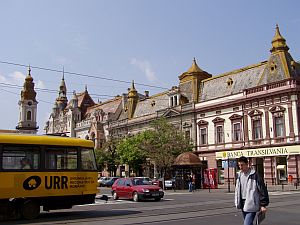
| ||
| In the centre of town - Oradea |
The mountains outside got bigger and the weather looked worse. As soon as we arrived in Transylvania, it started raining. I knew it! That was perfectly clear! Yes, I'm back to Transylvania... After more than 5 hours on the train (hence this train was even slower than trains in Georgia and Armenia!) we jumped off in Cluj-Napoca, also known as Klausenburg. The rain was strong and additionally it was pretty cold, and so we took the nearest hotel. It was a bit away from it all, which we found out when looking for a place to eat. The restaurant was worth the effort - high-quality Romanian food in huge amounts.
Relevant links: →Romania | →Oradea | →Cluj-Napoca
Day 3: Cluj-Napoca (Klausenburg)

| ||
| Great: rain in the daytime, clear sky at night |
Pretty frustrated we decided to spend the rest of this rainy day in museums. Alas, it's Sunday and all museums are closed. Soaked to the bones we went back to the hotel. The one and only highlight was a visit to the so called Music Pub, which is a sort of a student's drinking hall. A clear drink which cost much less than it had percents (in cents of course) saved the day. At night, the sky cleared up and temperatures fell almost below freezing point.
Relevant links: →Romania | →Cluj-Napoca
Day 4: Cluj-Napoca → Iaşi
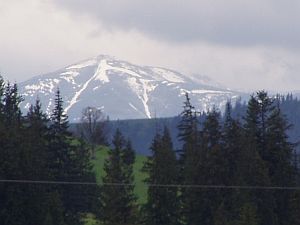
| ||
| Romanian mountains in springtime |
But she got out of the train. Instead of her a small boy begging for food entered the compartment. Bad timing, because we had already finished all our food. He pointed at our plastic bag and I said "Nu!" (guess what it means), but too late - he already examined our waste bag and looked disappointment. Curiosity killed the cat. Shortly after 6 p.m. and on time we arrived in Iasi. This place looks completely different to Western Romania - somehow it's dirtier and more vibrant. Soon we discovered a hotel and a good restaurant. The restaurant was a traditional one with a nice atmosphere, only disturbed by a huge Japanese group partying. I knew it - they are really everywhere. It always reminds me on the story with the hedgehog and the hare. A long and cold ride on the train is a good excuse for a nice beer in the hotel bar, which rather looked like a cheap drinking hall. Next to our table was a Romanian with his family asking me "Are you from Germany". I nodded and asked him why he speaks German so well. Of course he was working in Germany for a couple of years. Asked for the job, he smiled and replied "I was a pimp! I ran two brothels". His family confirmed that with a smile. Why not. Guess he wasn't such a nice guy at working time...
Relevant links: →Romania | →Cluj-Napoca | →Iaşi
Day 5: Iaşi
Again it's raining. It's really frustrating. I looked out the window and couldn't trust my eyes. Didn't I go to Romania a few days ago!? Why is there a tram from the German city I'm living in? Indeed, it's the tram from a line I used to take a lot when I was studying. Funny enough, the German ad for the local newspaper still covers the entire tram. At least they could have taken off the ads. Later we found out that almost all trams were imported from various German cities. After a breakfast at Fornetti, which nowadays can be found all over the country, we walked to a small monastery, which was under construction - we couldn't see anything. It was still raining, but we hoped for better weather and took a tram to the famous Botanical Gardens of Iasi. We paid for the inner and the outer area. The inner area consists of few greenhouses, and although we had paid for it, access to large parts was denied without further explanation. Descriptions in English or German? Zero. It's a nice park, but I wondered why I had to pay two fees. But it had stopped raining. We went back to the centre to examine the departure time of busses to Moldova. Walking around all the time makes hungry, and after a long search we came across a new restaurant. Which seemed to be run by children only! Guess the cook was a child as well - lousy tepid food, but more expensive then the excellent restaurant we visited the day before.
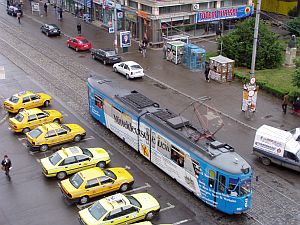
| ||
| German tram in Iasi |
We made a very big mistake when we bought some ice cream and tried to eat it while walking. Soon after, a small boy approached, tried to steal it, rounding us like a satellite and kept touching us. Sure I would have bought him an ice cream, too, but I couldn't reward his annoying manner. At the end, he was with us until we had finished the ice, and we were glad when we finished. At night we tried a pizza restaurant in the back of a night club. Staff were extremely friendly but surprised when we came in. Somehow I got the feeling, that we were the first customers at all. Maybe that's why they served pasta with cold ketchup!?
Day 6: Iaşi → Orhei (Moldova) → Pelivan
Shall we finally make it to travel Moldova!? It's the second try to erase this white spot on the map. Last year, they turned my mate down when we were trying to get a visa. This time, we were prepared and arranged visas beforehand, which was quite dramatic as well. We took the 10 a.m. bus, and after half an hour we'd already reached the border post. A rather fat woman asked me to lend her € 100. When I asked why, she explained that she couldn't enter the country without € 100 in cash. Really. Next to us sat a young Moldovian woman, and her passport told me that she must be a frequent traveller, too. She looked at us and translated the request. I understood, but I didn't see a single reason why I should give so much cash to a person I don't know at all. Of course I refused, and the young woman understood very well why.
Lining up at the customs, filling out a cash declaration, changing some money - that's it. Soon we continued the ride. It goes without saying that the fat woman didn't encounter any problems when crossing the border. In Moldova, everything looks more spartan. The houses. The vehicles. The clothing. But the villages are very nice and not seldomly completely made of wood. During a rest, we bought two ice-cream (again!) and paid 6 Lei, which is less than € 0.5. A strange feeling to pay only a few Lei - in Romania, it's always "xx thousand Lei, please".
Our destination was Pelivan (you'll need a very good map to find this!), a small village near Orhei, which is a small city near the small capital of small Moldova. There, the family of a friend was waiting for us. We were supposed to give Ljudmila in Pelivan a ring as soon as we entered Moldova, but the driver didn't let us use his mobile phone. Shortly before we arrived in Chisinau, we started talking again with our interpreter, the young woman. She asked us whether we want to make a phone call, and lent us her mobile phone. But it was hard to understand what Ljudmila was trying to tell us. We told her that we were on the way to Orhei, via the capital Chisinau. She misunderstood and said "Okay, let's meet in Chisinau! I'll be there in two hours, just wait." Oh no! We asked our interpreter to talk to Ljudmila and to tell her, that we were already on the bus to Orhei. "How much do you want for the phone call?" we asked, but she said "That's okay, I know how important it is to get help when in another country". I couldn't have said that better.
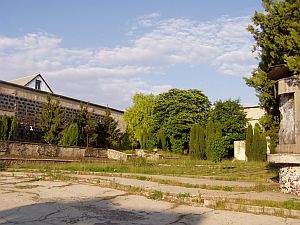
| ||
| The run-down community centre of Pelivan |
That is what we had already noticed before - there are animals everywhere. The entire country is a huge pet zoo. The village itself is rather new and has the typical structure of a Soviet Union style kolkhoz. In the appartment, Ljudmila's mother was waiting for us, bringing us to the kitchen soon after we'd arrived. Afer a couple of hours in the bus, a lunch is not a bad idea. Selfmade borscht, stuffed wine leaves and more - good traditional food. Soon we also got to learn Ljudmila's daughter. She speaks Russian and some Romanian "only", my mate speaks Japanese and German. Still they became friends and understood each other somehow after a while. Together we took a walk through the village and saw, that all buildings used by the community are extremely run-down and not in use any longer. We could also see a few new and pretty nice houses. Germans founded this village, but except for two, all Germans and many Moldovians left the village. Everyone who is able to leave the country leaves it - there is simply no work at all.
In the evening we got the chance to meet our friend's mother. Which means to eat again. Cake, fresh strawberries, cream, and would you fancy a brandy? At night we coincidentally met Ljudmila's neighbour and now the fun started. He was completely drunk and driving around the village in his old Kamas-Bus. He gave us a lift to the kiosk of the village - with the engine turned off, because it's a long slope. Wildly gesticulating, he kept on talking in Russian with an amazing speed. He is a nice guy, but somehow melancholic.
Almost at midnight, Ljudmila grabbed her daughter and left us alone. We had no idea that we would cause so much trouble, but there's no way to protest - it's Russian (although she isn't Russian) hospitality. To my mates regret, she also took the kitten with her.
Day 7: Orhei → Orheiul Vechi
To visit Old Orhei is today's goal, which we'd already discussed it with Ljudmila. She'd told us, that there would be a bus to Old Orhei but no bus back - at least not at the same day. A friend of hers offered to bring us there and back for € 10, but we kindly refused. Not because it is too expensive (which it certainly is), but for the reason that we wanted to explore Old Orhei slowly without someone standing in the back impatiently waiting for us. After a quick breakfast we went to Orhei and walked around the city. It was market day and much to see. To push the local economy, we bought a magnetic chess board - made in China, of course.
Shortly before 1 p.m., the very old bus, usually to be found in museums only, left for Trebujeni, a small village near Old Orhei. Because it's market day in Orhei, the bus was already completely packed one hour before departure. Every second passenger had a cardbox full of cheeping chicks. Of course, the ride took longer then expected. One of the passengers guessed where we want to go and told us, where to get off the bus. It was an impressive view - we stood in the middle of a huge natural limestone theater. We walked down a small road and climbed a narrow ridge with a church and a bell tower on top of it. Below the tower is an underground monastery, consisting of countless artificial caves. A small boy followed us and showed us around. This I know from some other countries, and I thought I should give him some money to get rid of him. He refused and said "don't want any money". What have I done? Too much travelling makes insensible - something I always try to avoid, but sometimes things like that happen. However, now we knew how to talk to kid and enjoyed his company. He showed us the church and his pets - among them a smiling dog with buckteeth. The boy seems to live in the nearby village and it looks like he has much time to spare...
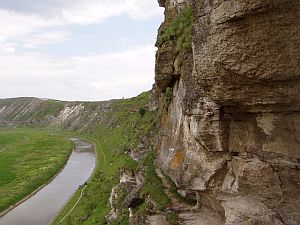
| ||
| A view from the inside of the monastery in Old Orhei |
Finally we entered a bigger village and even found a restaurant. We were hungry and wanted to go on, but before we could open the door, someone honked. It was a private (=illegal) taxi, and the driver offered to bring us to the next motorway for a handful of Lei. Because it was already late, we asked how much he would take to bring us all the way to Orhei. € 3 only. The staff at the bus terminal in Orhei already knew about us and so we had a short chat about the day. It was already 7 p.m., and there was no more bus or marshrutka to Pelivan. Not even a taxi waited around there. After some 20 km walking in the heat we didn't really want to walk some more kilometers all along the motorway, and so we tried to hitchhike. No car. After a while, someone from the bus terminal brought us to the village, for money, of course.
The family was already waiting and started a huge supper with herring salad, traditional corn mush, beacon, cheese, chicken and so on. What a hospitality. Ljudmila told us that she would go to Russia together with her daughter the next day, and offered us to stay in her appartment for a few more days. We refuse. It's a tempting idea, but we didn't want to overuse her hospitality. In the evening, we talked to Ljudmila and her family in German and Russian and many gestures. The daughter's classmate came along as well to practise som English. This is how the great time in the Moldovian countryside already came to an end.
Relevant links: →Moldova | →Orheiul Vechi (Old-Orhei) | →Orhei
Day 8: Orhei → Chişinău (Kischinov)
In the early morning we said goodbye to the family and the cat and took the next marshrutka to Orhei. A last chat with the staff of the kiosk - a Russian woman, who is very friendly and told us to "be lucky!" countless times. Another bus took us to the capital. During the next days we wanted to explore other parts of Moldova by bus, and so it was best to stay in a hotel near the bus terminal. We decided to go for the hotel adjacent to te bazaar and bus terminal. Staff first showed us a suite, but we asked for a cheaper room. The room even included a fridge, warm water (!) 24 hrs a day and a balkony, from where we could watch the bursting market. The hotel is quite big, but only half of it is used as a hotel - on our floor, we had to pass a dentist and a gynaecologist before we got to our room.
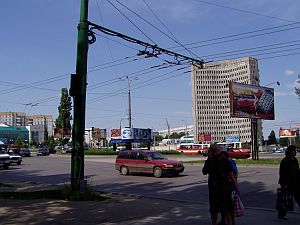
| ||
| I wonder what will happen with this ruin |
Chişinău is a surprisingly green and nice city with a strong socialist atmoshere. It makes fun to stroll around. Especially mobile phone shops mushroom all over the place. The streets are vibrant, and mysteriously no beggars can be seen - a big difference to Romanian towns. In the evening we tried a Jewish restaurant offering good service but much too noisy and untalented life music. We paid almost € 10 for a decent meal for two persons - quite a lot of money in this country. Back in the hotel, I checked the T.V. and found many English programs, e.g. Discovery Channel, National Geographic etc. The same as in Romania. According to Ljudmila, even Pelivan will be connected to the cable network in the near future. In Moldova, most things go wrong, but at least cable TV and mobile phones seem to boom. Strange priorities.
Day 9: Chişinău → Tiraspol → Bendery (Tighina) → Chişinău
To Transnistria! This small strip of land was quite often in the news in the beginning of the 1990ies. At that time, an absurd civil war (ok, civil wars are always absurd) broke out. With the help of the Russians, the Rebels even won the war. For us, it took only one hour by bus until we reached the (on maps nonexistent) border near Bendery. The Moldovians ignored the traffic completely - no wonder, they do not recognise the independence of Transnistria. Concrete foxholes and other military facilities line up along the small border stretch and give a strange feeling. At the Transnistrian side of the border we were granted special attention. An officer demanded US$ 5 each, but we didn't have dollars so he wanted € 5 instead. While asking for money, he filled out two colourful pieces of paper called talon. I didn't believe in discussing with officials of an unofficial country and the bus was waiting for us, so I paid and he handed over the talons, saying "You can keep this! Souvenir from Transnistria!" Was that a bribe!? With a proper receipt? We didn't know. The energetic and slightly dominant bus conductor, an older woman, forced the officials to hurry up with our registration. There, also Transnistrian citizens holding brandnew passport with "CCCP" (Russian for USSR) were waiting in line.
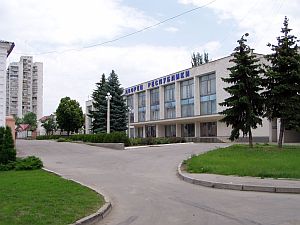
| ||
| Palace of the Republic in Tiraspol |
Tiraspol doesn't look like a capital at all. A few shops, a run-down Palace of Culture, a tiny Palace of the Republic and a dubious president's residence. Still in sight of the president's office, some old people sold their very last goods and chattels. Monuments everywhere honour the heros of the wars against Afghanistan, Moldova and so on and remind the visitors, where they are: In the glorious Pridnestrian Moldovian Republic. We walked the outskirts of Tiraspol to see some more of the city and stopped at a bus station. Two soldiers were lurking at the bus station. One was completely drunk, with the other one trying to wake him up, which included all kinds of measures - shouting, beating and so on. No way - the vodka was stronger.
After that, we explored Bendery, which became the scene of a bloody civil war in 1992. Today, not much reminds on that war. Still, Bendery is a drab place and looks much poorer then the Tiraspol. Especially at the bus station, even beggars can be seen. Coincidentally we came across a church and were surprised to see, that service was well visited. At least this is different to the former U.S.S.R. We were surprised by the friendliness of people in Transnistria. Sure, people in Moldova are very friendly, too, but in Transnistria even the staff was okay. Slightly exhausted from all the impressions and long walks, we returned to Chisinau without any problems at the border.
Relevant links: →Moldova | →Chişinău | →PMR (Transnistria) | →Tiraspol | →Bendery
Day 10: Comrat
We were still staying in Chisinau, and so we had the same procedure as everyday: I paid the room for the next night and went to the shabby cafe near the hotel, where people had substantial amounts of vodka even in the morning, to grab some coffee. After that, we moved to the Southwest bus terminal by microbus. Amazingly, some 20 passengers managed to get on the transporter. I had to stand next to the driver making a deep bow and needed to be careful not to fall into the steering wheel.
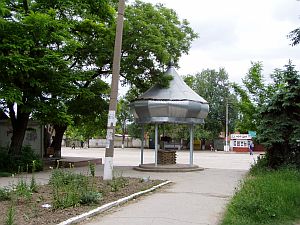
| ||
| The city centre of Comrat |
In the evening we headed for a restaurant which we had seen the day before. But we were turned down at the entrance - dress code! Next time I will be backpacking, I'll have to bring my suit. Next try was a place called Restaurant Chisinau. A probably 80 years old porter in livery welcomed us with dignity. The restaurant itself was huge and dark, but only three guests were sitting there. This place has definitely had better days. The waitress is old-school and trying hard to tell us which items on the menu are not available. Still, the food is okay and prices are reasonable not to say cheap. This place was a real step back in time.
It was the last evening in Moldova, and so we gave a try and stepped into a modern bar in an underground passage. The drinks we had ordered came much too late and were wrong. They corrected it, but soon after we'd got our drinks, the waiter came again and told us that they want to close in 15 minutes. Quite a surprise, because it wasn't even 11 p.m. Two minutes after we'd been told that they are going to close in 15 minutes, the waiter approached again, only to tell us "Sorry, but we don't close in 15 minutes but right now!" At the same moment, all lights went on and we had to pay within seconds. Welcome to the fascinating world of gastronomy in Chisinau!
Relevant links: →Moldova | →Chişinău | →Comrat (Gagauzia)
Day 11: Chişinău → Bălţi → Botoşani → Suceava
Time to say goodbye to Moldova. We had a great time in a country with mostly friendly people. And we hadn't been ripped off a single time - no one even tried. More amazingly, we hadn't seen other travellers at all during the entire stay. We didn't want to leave the country the same way we came in, and so we took a bus to the so called "Northern Capital", Balti a.k.a. Belzi. The bus was very old, and we found a place in the back on oil soaked dirty seats with a huge tyre next to us. In every curve, I watched the tyre hoping that it wouldn't start moving and squeeze us.
At noon we arrived Balti. The bus terminal is vibrant but pretty dirty. After buying tickets for the next bus, we'd had two hours time to spare. We walked outside the bus terminal, had a quick and cheap lunch, spent some money and exchanged the remaining Moldovan Lei into Romanian Lei. In our bus, an annoying woman drivelled something about cigarettes and whether I can't take some - at least one package. I had my own cigarettes and had no clue what she wanted from me. The bus is quite full, except for the seats in the back. We wondered why and sat down, but after an hour or so we understood. In a small village, some more passengers with sacks full of sunflower seeds and other huge bags came in and built a wall around us.
The border is in the middle of nowhere. Before we arrived, we had a nice chat with all the people around us - mostly in Russian. We were the one and only strangers on the bus and it was fun to talk with the people. Before the border, all passengers suddenly became active. They filled countless boxes of cigarettes into tights and wrapped the tights around their bodies. In addition, they crammed more cigarettes into their bras and every space available. Even a little boy got prepared - before a skinny, he soon became a fatso. So that is what the woman wanted us to do - to help her smuggling. The Moldovan border guard collected everyone's passport. Moldovan passports are blue, ours are red. He discovered our passports and started looking for us. After he had discovered the "strangers", he started a small quiz - about why we'd visited Moldova, whether we have friends there and how did we come to this desolate border post anyway!?
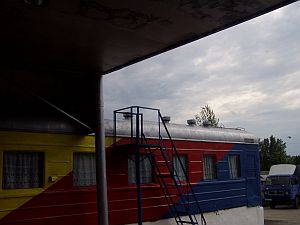
| ||
| The Moldovan border post |
Romania is really a rich, well developed country! This was my first thought when we returned to Romania. The streets, the cars, the buildings - compared to Moldova, Romania is heaven. The smuggling Moldovans explained, that they do the trip almost every day. When the passport is full, they simply apply for a new one and go on like that.
It was already past 8 pm when we arrived in Suceava. We checked the prices in three hotels, but all of them are quite expensive. We chose the most central hotel and checked in. Staff was friendly and rooms were great - all in all the price is fair. At the counter, they recommended a good Italian restaurant nearby. And we weren't disappointed - genuine Italian food, high quality and with reasonable prices. In the hotel, we bumped into an Austrian pensioner group discussing with the staff. "Welcome back to civilization!"
Day 12: Suceava - Cinci Mănăstiri (The five Monasteries)
We've already heard a lot about the famous fortified monasteries and fortress-like churches of Southern Bucovina, and so we were quite curioused about it. The problem is, that these five monasteries are scattered in a rather large area, which makes it difficult to see more then two on one day when using public transport. Since we didn't know exactly how much time we would need to return to Hungary, we went for the luxury thing: We chartered a car and a driver. We compared the prices of two different travel agent's, but it was almost the same - Lei 2.5 million. Which is around € 60 and quite a lot of money, but on the other hand the driver has to cover a distance of some 200 km, and the whole trip takes around 7 hours.
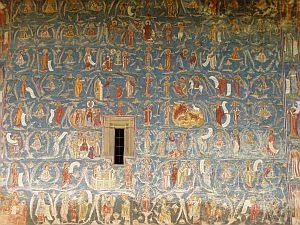
| ||
| Frescos in the Voroneţ Monastery |
In Arbore, the last one on our tour, smoke arose from the middle of the village, and the entire population had gathered. The reason was an old wooden building next to the monastery burning down completely. Since everything's made of wood, nothing could be done to stop the fire. In the monastery, a very kind woman approached. "Are you students?" she asked, and we answered "No". But with a wink of the eye she said "Of course you are students! Here are your discounts tickets!". Which means half price. After that, she showed us around and explained everything - in French. Oh my god. Everything but French! It had been quite a while that I talked in French, and so it gave me a good deal of headache. But somehow we understood each other well. This woman, keeper of the Arbore Monastery, had an open heart and was one of the friendliest people I've ever met during my travels.
Five monasteries are nice, and six would have been one too much. Quite exhausted and very hungry we arrived in Suceava again at 4 p.m. The villages we'd driven through were very impressive as well - one cannot help to stare at every farmer's house along the road in admiration. After a snack we walked around Suvceava, but except for the fortress there wasn't much to see. Due to the lack of attractive alternatives, we went for the Italian restaurant again. The waitress seemed to have a problem with calculations and gave back too much change. Since the service was good I tried to convince her that she was wrong, but strange enough it took a lot of argueing. It was really a pity that we couldn't explore more of Southern Bucovina with our own vehicle - this area is worth staying a couple of days.
Relevant links: →Romania | →Cinci Mănăstiri (Five Monasteries) | →Suceava
Day 13: Suceava → Vatra Dornei
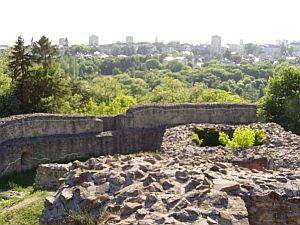
| ||
| Ruins of the fortress of Suceava |
The train compartment was full, but all the other passengers were nice people and so we talked to them for a while. We entered the mountains again and after three hours we arrived in small Vatra Dornei. Soon after getting off the train we fell in love with this place - nice, old buildings in a beautiful setting and fresh mountain air. A good chance to get away from all the big cities. We didn't have to search long for a cosy pension, where we seemed to be the one and only guests. In Vatra Dornei, everyting is only half the price we used to pay in other places - the accomodation, food etc. are really cheap.
Relevant links: →Romania | →Suceava | →Vatra Dornei
Day 14: Vatra Dornei → Vişeu de Sus → Sighetu Marmaţiei
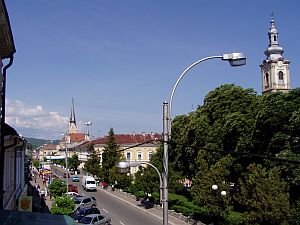
| ||
| The beautiful centre of town, Sighet |
On the other side of the pass, some hotels and holiday resorts can be seen. The bus went down the road for along time and entered the long village Borşa. According to the information from the bus terminal and what is written on the bus itself, this would be the final destination of the bus. That was why we only paid to Borşa. But the bus went on, which was good news for us, because it brought us closer to the place we wanted to go. The next small city is Vişeu de Sus, and there the bus finally stopped. For some reason it didn't go to the bus station. We asked the driver where the bus station is, but he told us that there wouldn't be another bus anyway. Unfortunately he was right. We walked the city for a while and took a seat in a small cafe. The staff told us, that there would be another bus passing the town and continuing to Sighet.
As the waiter said, the bus came at 5 p.m., in the bus many children. After they had spotted us, they giggled and tried to talk in English to each other. Later on, they talked to us, and thanks to them it became an interesting bus ride. Before arriving in Sighet, we crossed some more mountains again - with wooden, traditional villages everywhere. This area is called Maramureş and famous for its countryside. Now we knew why.
It was already quite late when we finally arrrived in Sighet. The town doesn't offer too much accomodation choices, and so we chose the hotel at the central square. In the entrance hall, a huge and noisy party was going on. After checking in, we looked for a restaurant, but all we could find was a pizza place. A quick drink in the hotel bar, and it was already midnight. All we needed to finish the day was a refreshing shower. While washing my hair, the water stopped flowing slowly. There was only enough time to rinse the shampoo - and that was it. Not a single drop. I went downstairs to the reception and explained the situation. The receptionist wasn't surprised at all - "Of course the water stopped! It's midnight!". "Wouldn't it make sense to inform your guests about this!?" I asked. And demanded a large bottle of water, so that we at least could brush our teeth. Eventually she agreed and handed out some water - for free, of course.
Relevant links: →Romania | →Vatra Dornei | →Vişeu de Sus | →Sighetu Marmaţiei (Sighet)
Day 15: Sighetu Marmaţiei → Satu Mare
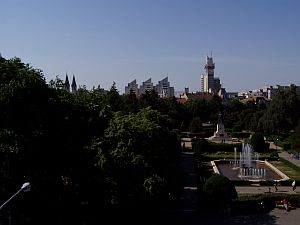
| ||
| View from the hotel on the centre of Satu Mare |
In the afternoon we arrived in Satu Mare and first went to the train station to check the departure time for trains to Hungary. On the map we'd seen that there is a track to nearby Debrecen, but there seemed to be no more train. Debrecen is only 150 km away, but to get there, we would have had to go to Oradea first and then to Debrecen - which takes 5 hours. Strange enough, there isn't even a bus. This was quite disappointing. To make things worse, the one and only cheap hotel in town was booked out. Therefore we had to go to a rather expensive but very nice hotel. In the hotel another group of Austrian pensioners was running around - it really looked like all Austrians aged 65 and above had been shipped to Austria. An extensive walk through the city brought us to some interesting places, but all in all Satu Mare is not too attractive. Obviously, many Hungarians live here.
Relevant links: →Romania | →Sighetu Marmaţiei | →Satu Mare
Day 16: Satu Mare → Mátészalka → Debrecen
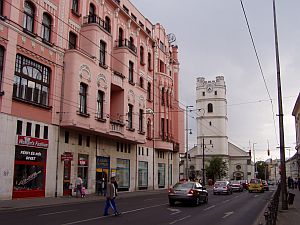
| ||
| A church without the top in Debrecen |
After a while, our driver said something with "Debrecen", but what exactly was he trying to tell us? Does he want to continue all the way to Debrecen? We didn't have the slightest clue and just nodded. Finally he did us a disservice - he brought us to the edge of the town, where the street to Debrecen starts. He probably thought that we wanted to hitchhike to Debrecen - but this time we weren't hitchhhiking to save some money but due to the lack of alternatives. We shortly tried to stop another car, but it was useless. So we started looking for the train station. I asked a man whether he could speak English. No way. But he called his daughter. She didn't speak English either, but perfect German. Train station? Go straight ahead, then left, cross the bridge et voilà! English might be useful in bigger Hungarian cities, but in the countryside it's German. After some searching we could find the train station. Fortunately we had some Hungarian money left - there was no ATM or exchange booth around.
A local train took us to Debrecen, where we got to know that tourist information is closed during the weekend. We tried the unusual way and asked at the reception of Debrecen's Number One Hotel for cheaper alternatives. The receptionist helped us out and explained the way to a nice pension. The town itself is good for a few hours walk, but not a real must-see. Still, the dinner was sensational - huge plates with game stew, selfmade noodles and much more. A typical Hungarian dinner so to say. However, after Moldova and Romania prices were shocking.
Relevant links: →Romania | →Satu Mare | →Hungary | →Debrecen
Day 17: Debrecen → Budapest → Vienna → Halle
Although we barely started our trip, it was already over. At least this is how we felt. If there wouldn't be a lack of time and money, we could have been already near the Ural mountain range or somewhere. But we couldn't help it and boarded the express train to Budapest. We were surprised by the speed of the train - fast travel was something we hadn't had for more then two weeks. In Budapest we had a few hours time to kill. Our night train started around 6 p.m., the compartment was full. Amazing, how much luggage other travellers take with them! Thinking about volume and weight, there was almost more luggage in the compartment then passengers. The conductor was extremely ... big. A few more sandwiches and he wouldn't be able anymore to walk along the corridor. A longer stay in Vienna helped us getting some dinner. And there was this certain night train phenomenon again - how can all people sleep at 10 p.m.? Is it some sort of mechanism? Automatic standby mode? It remains a mystery for me. At six in the morning, we finally arrived. From a much too short trip.
To visit Moldova was definitely worth the effort. However, it also gave an answer to the question, why only a few travellers go to Moldova. More than in other European countries, it's necessary to speak some Romanian or Russian. And it might be a good idea to have some experience in travelling other CIS countries. Moldova is more a country of hidden beauty, but can become a very rewarding destination.
The second tour through Romania has changed my mind. The first visit was interesting but also a bit stressful - probably due to the bad weather and the fact, that we'd only seen touristy Brasov and Bucharest. But travelling the North was extremely interesting - all people we'd met were very nice and there's much to see. It's definitely worth another visit. I wonder why this country still has such a bad reputation - when we travelled the country, all criminals and scams seemed to be on holiday....
Relevant links: →Hungary | →Debrecen | →Budapest | →Halle (Germany, Japanese only)
©2024 Europe-East.com

 Albania
Albania Travelogue Index
Travelogue Index